ICAN
Integrated Communication and control for All Needs
ir M.W. Nelisse,
ing J.A. van Woerden
TNO Institute of Applied Physics
PO Box 155, 2600 AD Delft
The Netherlands
tel: +31 15 2692004
fax: +31 15 2692111
email: nelisse@tpd.tno.nl
1. Summary
Emerging technologies, such as mobile communication, smart-home technology and handheld PC technology, enable improvements in all-day living tasks and are especially important for the quality of life of elderly persons and people with disabilities. In the ICAN project a portable device, a function carrier,will be developed with a set of building blocks (like interfaces to DECT, GSM, Batibus, Home Systems, PC and wheelchair) which can be customised to meet the needs of different user groups. The function carrier itself will be based upon a portable computer, like a Handheld or Palmtop PC, while the building blocks will be dedicated hardware and/or software modules. The overall integration method will be based upon the M3S architecture and communication principles, since this protocol follows an identical modular approach and allows easy implementation of devices via a complete set of hardware and software tools.
| Top|
2. Introduction
More and more domestic appliances become available to all citizens. Emerging technologies, such as mobile communication, smart-home technology and handheld PC technology, enable improvements in all-day living tasks. Although these products are even more important for the quality of life of elderly persons and people with disabilities, the products are very often not at all usable, due to the complicated user-interface and limited rest functionality of users. As a consequence, very often the value of this cheap general-purpose equipment cannot be used by these target groups.

The ICAN project is about convergence of the aforementioned technologies and intends to improve communication and control capabilities for people with special needs by simplifying and improving the users' ability to communicate, both face to face and at a distance, and to control equipment and devices in their homes or workplaces.
In the ICAN project a portable device, called a function carrier, will be developed with a set of building blocks which can be customised to meet the needs of different user groups, and which is able to communicate with different types of domestic appliances and equipment in (smart) houses. Furthermore for users of powered wheelchairs it should become possible to incorporate the new device on the wheelchair, such that the user can use a single control device for driving the wheelchair and for controlling the environment.
The technology used for the function carrier will be based upon a portable PC, the buildings blocks will use existing interface components as much as possible and the overall architecture will use the M3S communication principles.
| Top|
3. Function carrier
The function carrier will follow an architecture in which building blocks (like interfaces to DECT, GSM, Batibus, Home Systems, PC and wheelchair) can be combined into a solution for different types of users and which supports a suite of access functions. The function carrier itself will be based upon a portable computer. Several approaches are foreseen.
One approach will be based on a Handheld or Palmtop PC running the Windows CE operating system. This will result in a very small and lightweight function carrier, which is excellent for applications where the function carrier is not mounted on a wheelchair, but for example is carried directly by the user.
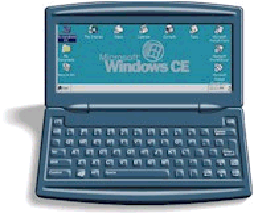
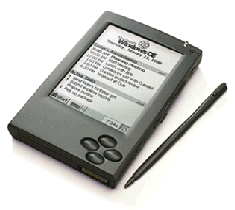
Figure 1 & 2: Function carrier based upon commercially available Handheld or Palmtop PC's from various manufacturers, running the Windows CE operating system.
Another approach will be based on a Portable PC running the Windows 95 operating system. This will result in a slightly larger function carrier, which is better suited for applications where the function carrier can be mounted on for example a wheelchair. A big advantage of this approach is that already more suitable building blocks are available.
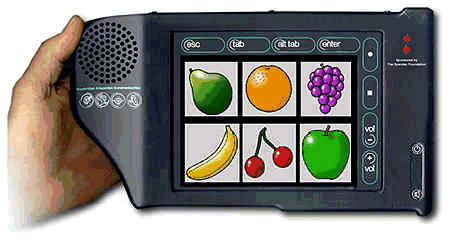
Figure 3: Function carrier based upon commercially available Cameleon CV from CAC, running the Windows 95 operating system.
A third approach can be found in a more conventional modular structure, where the function carrier is an embedded PC and the building blocks are separate devices. This will result in a less integrated function carrier but due to easier and cheaper integration mechanisms it is very likely to become a first test-bed of the function carrier principle.
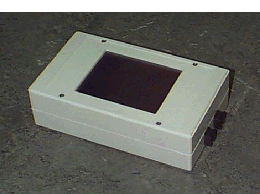
Figure 4: Function carrier based upon commercially available embedded PC, running with M3S framework software.
The building blocks can be implemented in hardware and/or software. Hardware modules can be installed inside the function carrier, be placed on top, below or next to the function carrier, or simply just connected to the function carrier via a cable. Software modules can be programs running as parallel applications within a multi-tasking capable environment, like Windows. Currently the following building blocks are foreseen:
- speech input unit,
- dynamic keyboard unit,
- control and configuration unit ,
- feedback unit (graphical user interface component),
- PC emulator unit (mouse and keyboard input emulation),
- serial keys unit (interface to desktop PC running Windows 95),
- infra-red environmental controller unit,
- interface to a GSM telephone,
- interface to the Control Dynamics DX bus,
- interface to a homebus (Batibus, HS, EI, Echelon),
- interface to the M3S bus (plug in with 'PC-Card' form-factor).
| Top |
4. M3S
M3S stands for Multiple Master Multiple Slave and is an integration strategy based upon a modular architecture which is meant to improve access to assistive technical devices in the rehabilitation field. With M3S, it is possible to connect input devices (like joysticks and keyboards) to end-effectors (like wheelchairs, robots and infra-red remote controllers) to form an integral aid which offers disabled people better opportunities to function as independently as possible. Since M3S is based upon a modular architecture, it allows users (disabled people, attendants, therapists) to compile a specific package of any combination of technical aids to a complete integral system, while still permitting them to extend or modify the system later on. Furthermore the system can be used right-away without any special adaptations using the M3S plug-and-play capabilities. The power of such an integrated system has been shown in several user evaluations in various countries around Europe.
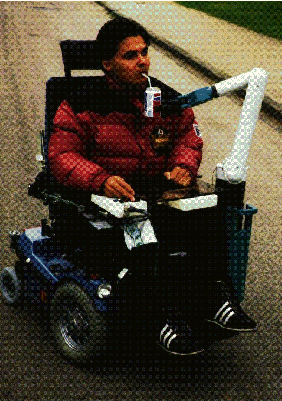
Figure 5: M3S based system with devices supporting mobility, manipulation and control of the environment.
The M3S specification is an open standard available for free, M3S has also been proposed to the ISO for formal standardisation. For the development of M3S devices a complete set of hardware and software tools is available, which greatly reduces the time to develop new devices. Information about M3S can be acquired from the M3S web server (http://www.tno.nl/m3s/) maintained by the M3S Dissemination office.
| Top|
5. Conclusions
The ICAN project will result in a function carrier and several building blocks which can provide the integration of various communication and control needs of elderly persons and people with disabilities in such a way that it will give these users serious improvements in their all-day living tasks.
| Top |
6. Acknowledgements
The ICAN project is supported by the Telematics Applications Programme of the European Commission, DG XIII C/E. Partners in the project are Cambridge Adaptive Communication (CAC - Cambridge, United Kingdom), Central Remedial Clinic (CRC - Dublin, Ireland), Swiss Foundation for Electronic Aids (FST - Neuchatel, Switzerland), Institute for Rehabilitation Research (IRV - Hoensbroek, the Netherlands) and TNO Institute of Applied Physics (TNO-TPD - Delft, the Netherlands).
| Top|
7. References
1 Dillon, B.; 1995; M3S A general­purpose Multiple Master Multiple Slave intelligent interface for the rehabilitation environment; in Proceedings of the Symposium on Powered Vehicles for Disabled Persons, Porthsmouth, 1995
2 Linnman, S. & J.C. Gabus; 1993; The M3S standard; in Proceedings RESNA '93, Las Vegas
3 M3S Consortium; 1993; A safe and easy to use integrated control and communication method, M3S; in Rehabilitation Technology, Strategies for the European Union; Proceedings of the 1st TIDE Congress, Brussels, Studies in Heath Technology and Informatics, vol. 9, p. 75­78
4 M3S Consortium; 1993; M3S, a general purpose interface for the rehabilitation environment; in Proceedings ECART 2, Stockholm, p. 22.1
5 Nelisse, M.W.; 1995; M3S: A general­purpose integrated and modular architecture for the rehabilitation environment; in2nd international CAN Conference '95, London
6 Nelisse, M.W. & G.R. Overboom, et al.; 1997; A general­purpose integrated and modular architecture for the rehabilitation environment; in Mobile Robotics Technology for Health Care Services; Proceedings of the 1st MobiNet Symposium; Athens, p. 161­170
7 Nelisse, M.W.; 1998; Integration Strategies Using a Modular Architecture for Mobile Robots in the Rehabilitation Field; in Journal of Intelligent and Robotic Systems, Kluwer, Dordrecht
8 Oderud, T. & G. Boersma et al.; 1994; Integrated System for Mobility and Manipulation for Disable People; in Fourth International Conference on Rehabilitation Robotics, Wilmington, p. 65­67
9 Woerden, J.A. van & J.C. Rosier; 1992; Integrated Control of mobility, manipulation, communication and the environment; in Proceedings RESNA '92, Toronto, p. 575­579
10 Woerden, J.A. van & M.W. Nelisse et al.; 1994; M3S ­ a standard communication architecture for rehabilitation applications; in Computing and Control Engineering Journal, IEE, London, p. 213­218
11 Woerden, J.A. van & M.W. Nelisse; 1995; Integrated solutions for assistive devices; in The European Context for Assistive Technology; Proceedings of the 2nd TIDE Congress, Paris, Assistive technology research series, vol. 1, p. 387­392
12 Woerden, J.A. van & M.W. Nelisse; 1995; Integration technology for integrated systems of assistive devices; inProceedings of the 3rd ECART Congress, Lisbon, p. 238­240
| Top | | TIDE 98 Papers |
